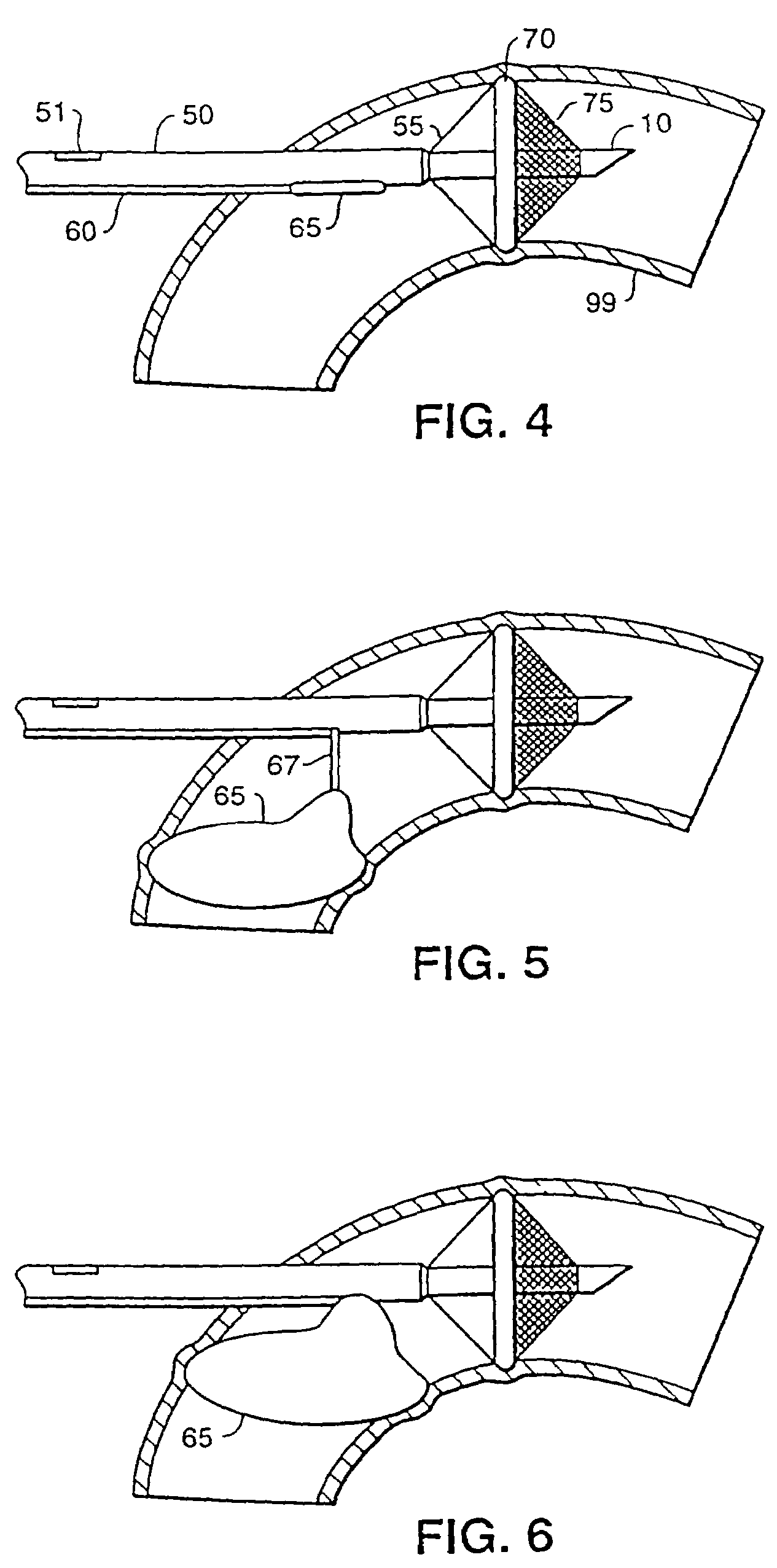[0038]Transesophageal echocardiography (TEE), another standard
visualization technique known in the art, is significant in the detection of conditions which may predispose a patient to
embolization. TEE is an invasive technique, which has been used, with either biplanar and multiplanar probes, to visualize segments of the
aorta, to ascertain the presence of
atheroma. This technique permits physicians to visualize the
aortic wall in great detail and to quantify atheromatous aortic plaque according to thickness, degree of intraluminal protrusion and presence or absence of mobile components, as well as visualize emboli within the
vascular lumen. See, for example, Barbut et al., “Comparison of
Transcranial Doppler and Transesophageal Echocardiography to Monitor Emboli During Coronary
Bypass Surgery,”
Stroke 27(1):87-90 (1996) and Yao, Barbut et al., “Detection of Aortic Emboli By Transesophageal Echocardiography During
Coronary Artery Bypass Surgery,” Journal of Cardiothoracic
Anesthesia 10(3):314-317 (May 1996), and
Anesthesiology 83(3A):A126 (1995), which are incorporated herein by reference in their entirety. Through TEE, one may also determine which segments of a vessel wall contain the most plaque. For example, in patients with aortic atheromatous
disease, mobile plaque has been found to be the least common in the
ascending aorta, much more common in the distal arch and most frequent in the descending segment. Furthermore, TEE-detected aortic plaque is unequivocally associated with
stroke. Plaque of all thickness is associated with
stroke but the association is strongest for plaques over 4 mm in thickness. See Amarenco et al., “
Atherosclerotic disease of the
aortic arch and the risk of
ischemic stroke,” New England Journal of
Medicine 331:1474-1479 (1994).
[0040]Through
visualization techniques such as TEE epicardial aortic
ultrasonography and
intravascular ultrasound, it is possible to identify the patients with plaque and to determine appropriate regions of a patient's vessel on which to perform certain procedures. For example, during
cardiac surgery, in particular,
coronary artery bypass surgery, positioning a probe to view the
aortic arch allows monitoring of all sources of emboli in this procedure, including air introduced during aortic cannulation, air in the bypass equipment,
platelet emboli formed by turbulence in the
system and atheromatous emboli from the
aortic wall.
Visualization techniques may be used in conjunction with a blood filter device to filter blood effectively. For example, through use of a visualization technique, a user may adjust the position of a blood filter device, and the degree of actuation of that device as well as assessing the
efficacy of the device by determining whether
foreign matter has bypassed the device.
[0041]It is an object of the present invention to eliminate or reduce the problems that have been recognized as relating to
embolization. The present invention is intended to capture and remove emboli in a variety of situations, and to reduce the number of emboli by obviating the need for cross-clamping. For example, in accordance with one aspect of the invention, blood may be filtered in a patient during procedures which affect blood vessels of the patient. The present invention is particularly suited for temporary
filtration of blood in an
artery of a patient to capture embolic debris. This in turn will eliminate or reduce neurologic, cognitive, and cardiac complications helping to reduce length of
hospital stay. In accordance with another aspect of the invention, blood may be filtered temporarily in a patient who has been identified as being at risk for
embolization.
[0042]As for the devices, one object is to provide simple, safe and reliable devices that are easy to manufacture and use. A further object is to provide devices that may be used in any blood vessel. Yet another object is to provide devices that will improve
surgery by lessening complications, decreasing the length of patients' hospital stays and lowering costs associated with the
surgery. See Barbut et al., “Intraoperative
Embolization Affects Neurologic and Cardiac Outcome and Length of
Hospital Stay in Patients Undergoing Coronary
Bypass Surgery,”
Stroke (1996).
[0044]As for methods of use, an object is to provide temporary
occlusion and filtration in any blood vessel and more particularly in any artery. A further object is to provide a method for temporarily filtering blood in an
aorta of a patient before the blood reaches the
carotid arteries and the distal aorta. A further object is to provide a method for filtering blood in patients who have been identified as being at risk for embolization. Yet a further object is to provide a method to be carried out in conjunction with a blood filter device and visualization technique that will assist a user in determining appropriate sites of filtration. This visualization technique also may assist the user in adjusting the blood filter device to ensure effective filtration. Yet a further object is to provide a method for filtering blood during
surgery only when filtration is necessary. Yet another object is to provide a method for eliminating or minimizing embolization resulting from a procedure on a patient's blood vessel by using a visualization technique to determine an appropriate site to perform the procedure.
[0045]Another object is to provide a method for minimizing incidence of thromboatheroembolisms resulting from cannula and
catheter procedures by coordinating filtration and
blood flow diffusion techniques in a single device. Another object is to provide a method of inserting or retrieving a cannula or
catheter with attached filtering means from a vessel while minimizing the device's profile and
diameter.
 Login to View More
Login to View More  Login to View More
Login to View More 


